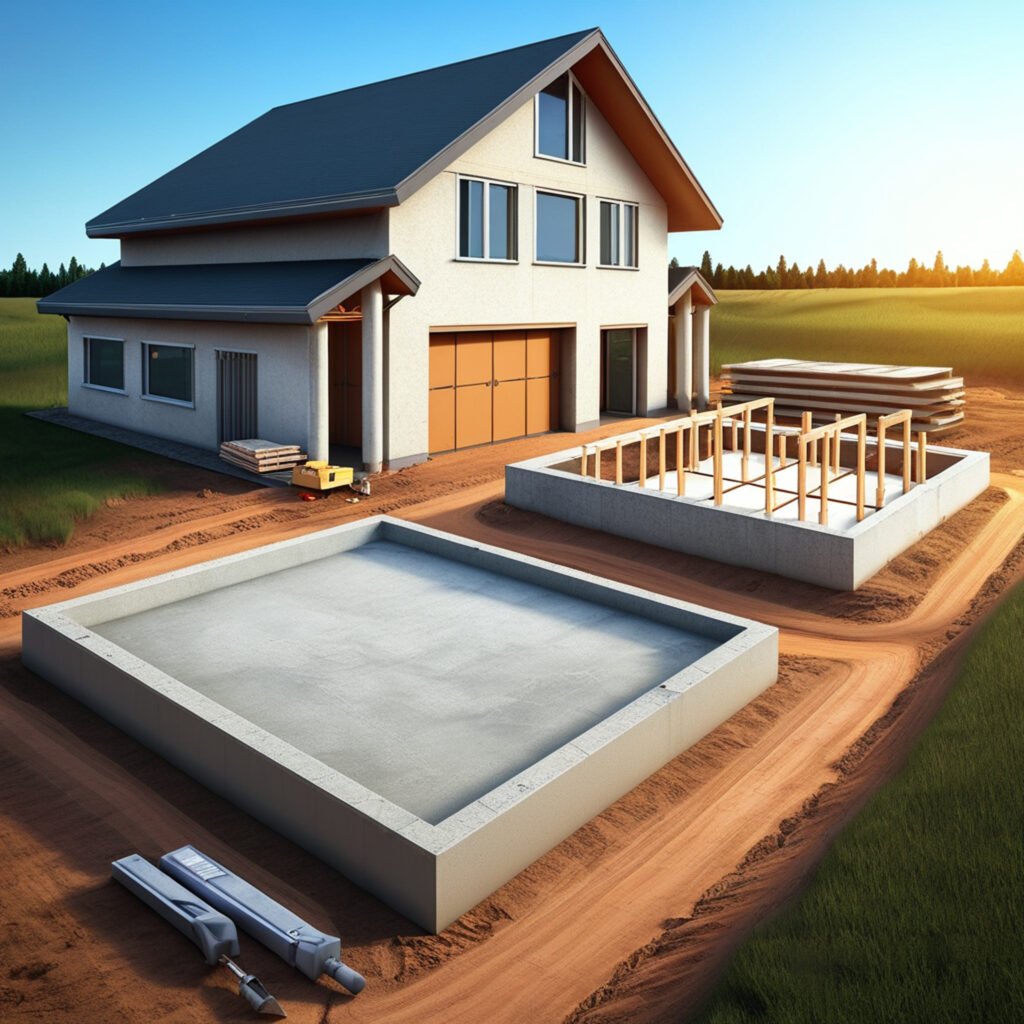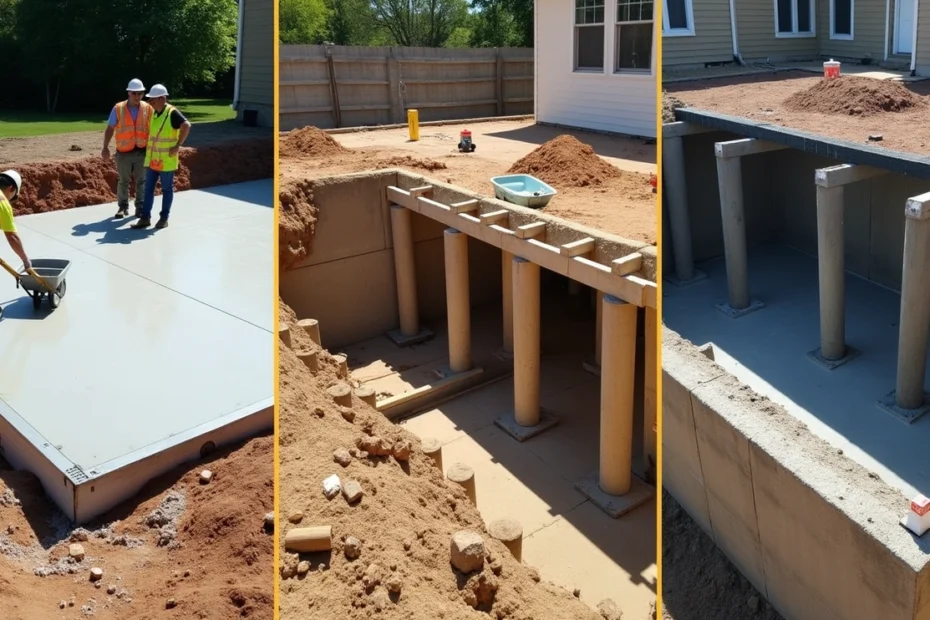The success of your building project largely depends on picking the right garage foundations. A concrete slab foundation stands out as one of the most cost-effective choices, with prices ranging from $8–$15 per square foot. These foundations have gained popularity because they last long and don’t cost much.
Most builders skip the crucial step of choosing the best foundation type. A concrete garage foundation creates a single monolithic structure that supports the entire building by pouring concrete over a prepared gravel base. The best foundation choice depends on your soil conditions, climate, and how you plan to use the space. This piece dives into the main differences between slab, pier, and beam, and elevated floor systems. You’ll learn which garage foundation depth and structure matches your needs perfectly.
Understanding the Main Garage Foundation Types
Your garage’s foundation affects its stability, longevity, and how well it works. Here are the three main types of garage foundations you’ll find in residential construction.
Concrete slab foundations
Concrete slabs are the most popular choice for garage foundations. They’re easy to install and last a long time. This type of foundation uses a thick, reinforced concrete pad poured right onto prepared ground. Standard residential garages need concrete that’s 4-6 inches thick. Garages built to house heavier vehicles like RVs might need slabs up to 6 inches thick.
A well-built concrete slab has thickened edges (footings) that go 8-12 inches below the slab to support the garage walls. These single-piece pours create a unified foundation that spreads weight evenly. Concrete slabs resist pests well and need very little maintenance during their 30+ year lifespan.
Pier and beam foundations
Pier and beam foundations use concrete piers as vertical supports deep in the ground with horizontal beams that spread the structure’s weight. The piers are usually 4 feet tall with 8-10 feet of space between them. This foundation works great in areas that have unstable soil, uneven ground, or frequent flooding.
Pier foundations give you a crawl space under your garage where you can easily access utilities. They need more expert planning and might cost more than slabs. Yet their ability to handle tough landscapes makes them a great choice in certain situations.
Elevated floor systems (crawl space, stem wall)
Elevated floor systems lift your garage floor above ground level and create usable space underneath. Stem wall foundations combine concrete footings with vertical walls that extend above ground level. These foundations work well for properties in areas that flood by providing needed elevation.
Crawl space foundations usually lift the structure 18-22 inches off the ground. This design creates a space under the garage floor where you can maintain electrical, plumbing, and HVAC systems. Two-story garages often use special elevated concrete floor systems. Options like prestressed concrete planks or corrugated metal decking with cast-in-place concrete make upper-level garage floors extra durable.
Each foundation type has its own advantages based on your property’s conditions, climate, and what you need the garage to do.
Key Factors That Influence Your Foundation Choice

You need to consider several key factors to choose the right garage foundation that works best for you. These factors help you balance cost, durability, and functionality to make a smart choice.
Garage size and load requirements
Your garage’s size and how you plan to use it will shape your foundation choice. Most residential garages work fine with a standard 4-inch concrete slab. You’ll need a 6-inch thickness if you’re planning to store heavy vehicles like RVs. The concrete strength matters too – you’ll need a minimum compressive strength of 2,500-3,500 pounds per square foot, based on your local climate.
Building codes often need deeper foundations for buildings larger than 1,000 square feet. You should also plan for reinforced areas if you’ll use heavy-duty floor jacks for vehicle maintenance.
Soil type and drainage conditions
The soil type affects your foundation’s stability a lot. Clay soil moves around as it gets wet and dries out, which can make your foundation shift. Sandy soil drains well but might erode as time passes. Silt holds moisture longer than sand and drains better than clay. Loam soil gives you the best foundation support because it mixes clay, silt, and sand in the right balance.
Good drainage matters, whatever type of soil you have. Your ground should drop at least 6 inches within the first 10 feet from foundation walls – that’s what codes usually say. Water can build up without proper drainage and create hydrostatic pressure that cracks and moves your foundation.
Climate and freeze-thaw cycles
Cold regions face serious risks from freeze-thaw cycles. Water in the soil expands as it freezes and pushes against foundation walls, then contracts while thawing. This back-and-forth movement can create or worsen foundation cracks.
You might need specially designed frost-protected shallow foundations that “float” on the soil if you live where temperatures swing wildly. This means foundations in cold climates need the right depth or insulation to stop frost heave damage.
Garage foundations depth and local codes
Local building codes tell you how deep your foundation needs to be based on the frost line depth. Northern regions usually need foundation depths of 42-48 inches below grade to get under the frost line. Smaller detached garages under 1,000 square feet can sometimes use monolithic slab foundations with thickened edges.
Building officials might ask for soil tests if they spot signs of expansive or unstable soils. These tests show the right load-bearing values based on soil classification tables in building codes.
Pros and Cons of Each Foundation Type
Each garage foundation option has its own benefits and trade-offs. You can pick the best foundation that fits your needs by learning about these differences.
Slab foundations: economical but rigid
Concrete slabs are the most economical choice for garage foundations, with costs ranging from USD 4.00 to USD 14.00 per square foot. This simple foundation dries fast and fights off pests and moisture well. These slabs last long and resist fire, rot, and insect damage.
In spite of that, slab foundations have some real drawbacks. The biggest problem comes when you need repairs – since utilities are buried in the concrete, you’ll need to break through the slab to fix plumbing or electrical systems, which gets expensive and messy. Slabs are also nowhere near as strong in freeze-thaw climates, where cracks can develop.
Pier foundations: flexible but need more care
Pier foundations work great on tough terrain. They adapt well to uneven ground and let you make changes later. These foundations are also better for the environment because they use less material and don’t disturb the soil much.
Of course, these foundations aren’t perfect. The floors can start to sag as the ground settles. The edges need regular adjustments, especially when soil moisture changes.
Elevated floors: easy to maintain, but cost more
Elevated floor systems give you great access to utilities through their crawl spaces. They are a vital part of protecting your garage in areas that flood often.
The biggest downside is that elevated foundations cost more than concrete slabs. You also need to check the ventilation regularly to stop moisture and pests from becoming problems.
Cost, Durability, and Maintenance Comparison

Let’s look at what garage foundations really cost and how different types stack up for budget-minded builders and homeowners who want lasting value.
Original installation costs
The cost of garage foundations changes a lot based on type and size. A concrete slab foundation costs between $5.00 and $16.00 per square foot. This makes it your most affordable choice. A quality concrete slab for a standard two-car garage will set you back $4,608 to $8,640.
Pier and beam foundations cost about $6.00 to $12.00 per square foot. These need more materials and skilled workers, which drives up the price. Floor systems with crawl spaces run $6.00 to $18.00 per square foot. You’ll pay more because they’re trickier to build and need extra materials.
Long-term durability and repairs
A well-built concrete slab can last 80-100 years without much upkeep. These slabs are tough but might crack sometimes. Small fixes usually cost $250 to $800.
Pier foundations last incredibly long but might need adjustments when soil shifts. Foundation fixes usually cost between $2,200 and $8,100. Big structural problems could hit $23,000.
Energy efficiency and insulation
Concrete slabs naturally help control temperature through thermal mass. Many homeowners boost efficiency by putting rigid foam insulation under their slabs. This gives R-values of R-4 to R-6.5 per inch.
Crawl spaces and pier foundations need extra insulation. You can choose from fiberglass batts ($0.30-$1.50/sq.ft.) to spray foam ($1.65-$3.80/sq ft.). Good insulation cuts energy bills and makes attached garages more comfortable.
Pest and moisture resistance
Concrete slabs keep pests out really well since there’s nowhere for termites or rodents to get in. For raised foundations, ¼-inch metal screening in vents stops rodents. Regular checks still matter, though.
Moisture resistance varies between foundation types. Slabs need proper sealing and drainage to keep water out. Moisture meters can spot high levels (above 4%) that might ruin floor coatings. Crawl spaces need good airflow and vapor barriers to avoid moisture problems that could weaken the structure.
Conclusion
Your specific circumstances and priorities determine the right garage foundation choice. This piece shows how concrete slabs are economical solutions for most standard garages, while pier foundations work better in challenging terrains. Elevated floor systems cost more but provide significant accessibility and flood protection.
The decision should align with your local climate, soil type, and budget. Concrete slabs perform well with stable soil and minimal moisture issues. Pier foundations suit uneven terrain better, and elevated systems are ideal for flood-prone locations.
Note that proper installation is vital, whatever foundation type you pick. All foundations will fail without proper drainage, correct depth specifications, and compliance with local building codes.
A structural engineer should assess your site conditions before you make the final choice. This step adds to your original cost but will definitely save money and prevent problems later.
Your garage foundation supports the entire construction project. The time you invest in making an informed choice now will give you decades of structural integrity and functionality. The perfect garage foundation exists for your unique needs, whether you value cost-efficiency, terrain adaptability, or long-term accessibility.
